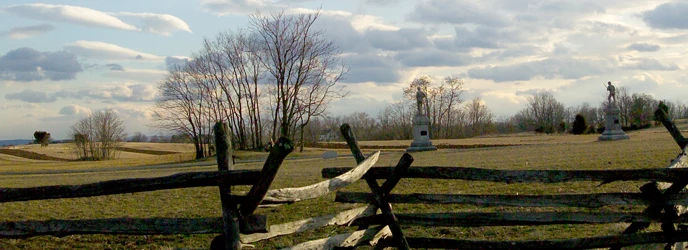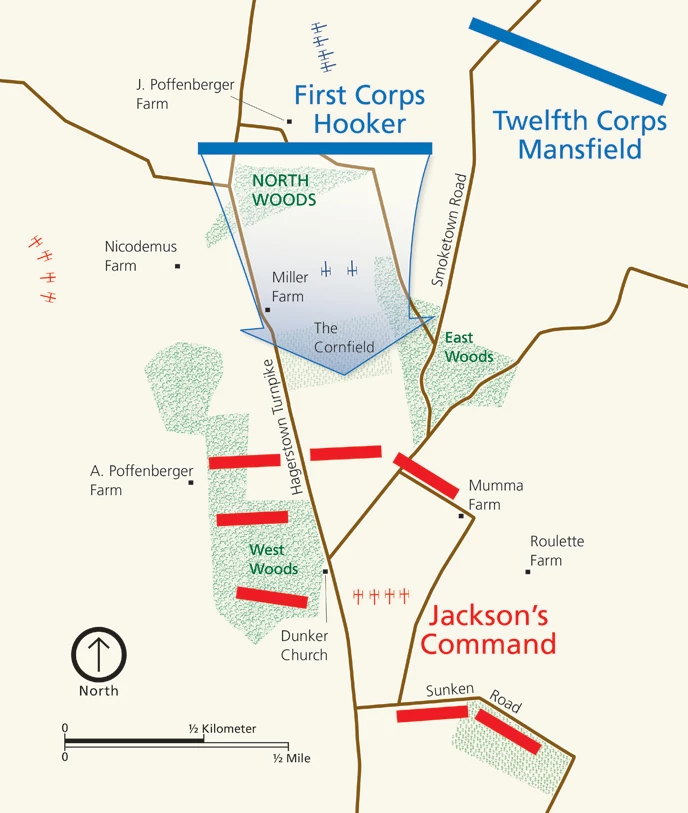
Introduction Union Gen. Joseph Hooker's men spent the night before the battle on the Joseph Poffenberger farm. At first light, the Union attack advanced south from here toward Jackson's lines. "The stars were still shining when [Hooker's] skirmishers became engaged," a soldier would later recall. The Culmination of Another Great Tragedy was at Hand "A foggy morning was the 17th of September," remembered Sgt. Austin Stearns, "and each army was astir and preparing for the deadly struggle that the lowest private knew was to take place." Pvt. Frederick Hitchcock wrote how, "all realized that there was ugly business and plenty of it just ahead." At the earliest blush of dawn, the deep toned thunder of artillery, mixed with the steady rattle of musketry, could be heard through the fog. The soldiers of the First Corps advanced south toward the catastrophe in the Cornfield, one-half mile to the south. Early that morning, Confederate cavalry commander, Gen. J.E.B. Stuart positioned more than a dozen cannon three-quarters of a mile southwest on high ground called Nicodemus Heights. Led by Maj. John Pelham, the shells from these guns devastated the Union soldiers as they advanced out of the North Woods and across the open ground toward the Cornfield. Federal artillerist Albert Monroe vividly remembered the fire that came from Pelham's guns: "…we could see the first rays of the sun lighting up the distant hilltops, when there was a sudden flash, and the air around us appeared to be alive with shot and shell…The opposite hill seemed suddenly to have become an active volcano, belching forth flame and smoke." 
TranscriptHello, this is Ranger Olivia Black. And I'm standing at Tour Stop 2, The Northwoods. It was in this area that the first core of the Union Army under General Joseph Hooker would camp the night before the battle. And in the early morning hours of September 17th, they advanced southwards from here towards a 25-acre cornfield, owned by D.R. Miller, that becomes some of the bloodiest ground on this entire battle. Today visiting the Joseph Poffenberger Farm, you can get a sense of what a typical farmstead looked like in 1862 and sense of the tenuous calm before the battle, a peaceful stillness edged with uncertainty. At the time of the battle, the farm you see in front of you was owned by Joseph and Mary Anne Poffenberger. They didn't have any children, but their nephew, Josiah, and an orphan they'd taken in, Isaac, were living on the property with them. We don't know where the Poffenberger family sheltered during the battle, but they had a network of relatives in the area, so they may have spent September 17th staying with them. The Union First Corps crossed over Antietam Creek, primarily using the upper bridge. On the afternoon of September 16th and began to set up camp on the Poffenberger farm. Joseph Hooker established his headquarters in the barn. Some of the Union soldiers skirmished with some of John Bell Hood's Confederate troops on the night of September 16th. Once the fighting died down, these weary soldiers settled into rest. But the sense that a major battle was impending escaped no one. In fact, General Joseph Hooker acknowledged this himself, “We are through for today, gentlemen, but tomorrow we fight the battle that decides the fate of the Republic.” Between the pressure of these words, the closeness of the battle lines, the certainty of an imminent conflict, and a rain that fell off and on, it must have been a restless, uncomfortable night. The high ground to the north of the Poffenberger house and barn was the perfect position for a number of union artillery batteries to fire S towards the cornfield and West to try and disable the Confederate guns on Nicodemus Heights across the Hagerstown Pike, which were able to reach the locations of most of the morning fighting. Artillery fire at Daybreak marked the beginning of the Battle of Antietam. After an artillery duel opened the day, soldiers of the Union First Corps began moving south through the North Woods and into the cornfield. Because of the terrain and the corn, which was nearly ready to harvest, soldiers knew little about what they would face. On the other side of the cornfield, Alexander Lawton's Confederate division was ready to spring into action. Fighting in the cornfield lasted until about 9:00 AM. You can learn more about this brutal combat at tour Stop 4. As casualties mounted, the Poffenberger barn was pressed into service as a field hospital and wounded soldiers streamed back into the area. Even more wounded soldiers and their battle weary but unharmed, comrades flocked to the area as the fighting in the West Woods came to a close around 9:30 in the morning. You can learn more about the fighting at the West Woods at tour Stop 5. Round noon Clara Barton arrived from Washington DC to deliver badly needed supplies. She tended to the wounded soldiers until nightfall. Today, this monument declare Barton stands at tour Stop 2. When the passengers returned, they found that although there had been little damage to their house and barn, their stores had become fuel for the hungry soldiers, Joseph Poffenberger wrote. I returned to the House, there was nothing left. I lived on army crackers that I had found on the battlefield for five days after the battle. The Union Army encamped on the Poffenberger farm through the rest of September and most of October, further depleting the stores that the family had put away for winter, despite submitting a claim, Joseph Poffenberger did not receive any compensation from the US government because he could not prove that Union soldiers had caused the damage. Ultimately his estate received almost $2000, a little over 30 years after the battle. Learn more about the troop movements and actions that contributed to the destruction of farmsteads in the area, like the Poffenberger visit tour, Stop 3 where the fighting began, and where reinforcements of the Union 12th Corps arrived as the battle in the cornfield raged.
Visit our keyboard shortcuts docs for details
Short video on Tour Stop 2, The North Woods. Go to the next tour stop - the East Woods |
Last updated: September 15, 2020
